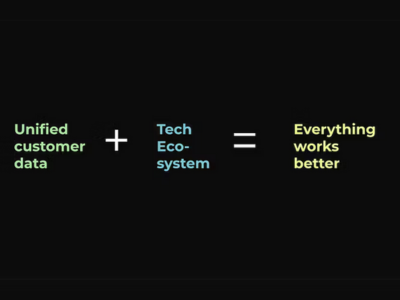CDP vs. CRM, What’s the Difference?
October 23, 2023The business technology ecosystem can be a confusing place, making it harder for marketers and technical teams to find the right tools they need access to accurate, up-to-date customer data.
In this article, we’ll focus on one of the more common questions, namely, what is a CDP (Customer Data Platform) what is a CRM (Customer Relationship Management Platform), and how do they differ?
What is a Customer Relationship Platform (CRM)?
Let’s start with the more commonly understood of the terms: CRM.
A Customer Relationship Management Platform (CRM) is a software solution designed to streamline and enhance interactions between companies and their customers. It serves as a centralized hub where companies can manage and analyze known historical customer data, communication channels, and sales processes.
CRM systems provide tools for customer support, marketing automation, sales tracking, and lead management. By using customer and potential customer data, CRMs enable businesses to build stronger one-to-one relationships, improve customer satisfaction, and enhance overall efficiency.
CRM software can also play a vital role in helping organizations foster long-term customer loyalty and increase revenue through personalized and targeted engagement.
What is a Customer Data Platform (CDP)?
A Customer Data Platform (CDP) is a technology solution with the primary function of consolidating and unifying customer data from various sources into a single, comprehensive database. This data typically includes CRM, sales data, analytics, and customer journey. CDPs collect and integrate data from various touchpoints, such as websites, mobile apps, social media, email interactions, and offline sources. The primary goal of a CDP is to create a unified and consistent customer profile, which includes behavioral, transactional, and demographic information. By organizing data in this manner, businesses gain a 360-degree view of their customers where individual customer data is clean, accurate and unified.
The CDP can then push profiles to a range of other platforms (including CRM) allowing for more effective communication, segmentation, personalization, and data-driven marketing strategies.
The difference between CDPs and CRMs
At first glance, there may seem to be some overlap between the functionality of a CRM and a CDP, however, on closer inspection, it becomes clear that the two platforms have very distinct jobs to do.
A CRM has tools for customer support, marketing automation, and sales management, and focuses on facilitating and enhancing customer interactions across the entire customer lifecycle. Crucially, however, a CRM can only work with the data that is fed into it. It does NOT have the ability to unify or improve data quality.
In contrast, a CDP solves the fundamental data quality problem so that it can feed other systems, including CRMs, with useful, accurate, and up-to-date data to power analysis and personalization in a variety of ways. CDPs may also have their own internal tools for analysis for marketing automation which can integrate with other systems.
The following table shows highlights some of the other differences between CRMs and CDPs:
| Focus | Facilitates interactions, communication, and engagement throughout the customer lifecycle. | Collects, unifies, and organizes customer data from various sources, to inform analysis and feed other platforms. |
| Functionality | Includes customer support, sales automation, marketing tools for improved satisfaction. | Built to capture data from websites, apps, CRM systems, email marketing. |
| Data Sources | Customer interaction, transactional records, support data. | Gathers online, offline, and third-party data for customer insights. |
| Data Usage | Uses customer data to personalize communications and manage real-time interactions. | Uses data to create profiles, segment audiences, and enhance targeting, personalization and measurement. |
| Application & Activation | Enables real-time customer engagement, automated sales, and marketing campaigns. | Creates unified profiles for personalized marketing campaigns. |
| Optimization Opportunities | Offers real-time updates, segmentation, and performance analytics for optimization. | Performs data cleansing, use identity resolution algorithms, enable segmentation. |
| Integration | Integrates with email, social media, phone systems for seamless communication. | Integrates with a wide range of marketing and analytics platforms and tools to power them with higher quality data inputs. |
| Use Cases | Used by sales and support teams to track interactions and drive sales. | Enables targeted campaigns, personalized experiences, data-driven decisions. Provides unified and clean data for more advanced insights and easier consent management and privacy compliance. |
As you can see, a CDP is primarily dedicated to unifying customer data from multiple sources, notably combining offline and online data, helping to create a comprehensive and accurate customer profile. In addition, CDPs such as Amperity’s offer advanced marketing functions, including an identity graph that increases match rates with media platforms, real-time personalization capabilities and direct integrations with media environments.
Implications for Enterprise Business
In summary, a Customer Relationship Management platform (CRM) serves as a solution for managing customer relationships, communication, and sales processes, whereas a Customer Data Platform (CDP) concentrates on collecting, unifying and cleaning customer data from to enable businesses to push this improved data into the platforms that they use including CRM, marketing channels and other customer platforms.
These platforms can complement each other when used in combination and play vital roles for businesses to understand their customers and prospects better and deliver more personalized and effective experiences. The CRM is essential for managing customer communications, yet it is the CDP that truly unlocks advanced capabilities for the businesses to operate where data is fragmented and disparate.
To learn more about how leading brands are using Amperity CDP to grow their business, check out our customer stories.


